It’s getting more expensive to be rich. Taxes on the wealthy went up on January 1, 2013. The price of the highest-end condos in New York is rising. Tuition at elite private schools is soaring. And, so, too, is the cost of settling thorny investment-related regulatory and legal matters—which, for many in the corporate and financial world, is a cost of doing business.

The latest billionaire to pay a hefty fine to get the government off his back is Steven A. Cohen, proprietor of the much-investigated SAC Capital. SAC in March agreed to pay a $616 million fine to settle Securities and Exchange Commission investigations into its trading practices, trumpeted as the largest-ever such fine. On Monday, SAC agreed to pay a record $1.2 billion to resolve insider-trading charges. Here’s the letter from U.S. Attorney Preet Bharara describing the settlement as “the largest financial penalty in history for insider trading offenses.” (The settlement is actually for $1.8 billion, but SAC Capital is getting a credit for the $616 million it already paid the SEC.) This one is also “the largest financial penalty in history for insider trading offenses.”
SAC isn’t the only household name to pay an eye-popping fine. On Monday, Reuters reported that Johnson & Johnson will pay $2.2 billion to settle Justice Department charges that it engaged in abusive practices and paid kickbacks to market the drug Risperdal. Meanwhile, JPMorgan Chase has been a veritable fountain of cash for regulators over the last few years, paying billions of dollars in fines to settle an array of charges. Last month, the bank agreed to pay a ginormous $13 billion fine to settle (it hopes, once and for all) charges relating to the packaging of mortgages in the credit boom by JPMorgan Chase, and by two banks it had acquired—Bear, Stearns and Washington Mutual.
What’s behind these huge sums? A few factors.
First, five years after the Lehman Brothers collapse, regulators and prosecutors are eager to feed the public’s appetite for revenge. Millions of Americas lost their homes, tens of millions saw their 401(k)s get socked, but the reckless banks got bailed out, gorged on free money from the Federal Reserve, and then fought needed regulations. Few, if any, of the top dogs at major financial firms were prosecuted, or even held to account.
Second, there are new sheriffs in town. The swashbuckling efforts of Bharara, U.S. Attorney for the Southern District of New York, have landed him on the cover of Time. And in Washington, SEC Chairman Mary Jo White is encouraging her staff lawyers to get tough with Wall Street. A former U.S. Attorney for the Southern District of New York, White spent a decade at white-shoe firm Debevoise & Plimpton, where she did work for many financial firms, before joining the SEC last spring. White is a hard-nosed prosecutor who is eager to declare her independence from Wall Street, and to make a name for herself in the next few years.
In effect, White and Bharara are upending the cozy, hypocritical culture of settlements. Typically, rather than litigate against expensive powerhouse lawyers, regulators and prosecutors would eagerly strike deals. Companies and individuals would pay fines to settle charges, in which they would neither deny nor admit wrongdoing. And then they’d go about their business as if they had done nothing wrong.
Here’s the thing. As banks and hedge funds grew ever-more larger and more profitable, the fines—even what appear to be very large fines—grow meaningless. In Washington, $300 million or $600 million may seem like a lot of money. But for truly massive banks and hedge funds, it’s chicken feed. They’re able and willing to pay those fines the way you and I would pay $50 or $100 to make a speeding ticket go away. So JPMorgan Chase could pay billions of dollars in fines and still rack up billions of dollars in profits, enough to pay its dividends and lavishly reward its top executives. Cohen and SAC in March agreed to pay a $616 million fine to settle insider-trading charges. That would be enough to sink most people, and the SEC trumpeted it as the “largest-ever settlement for insider trading case.” But the next week, Cohen splashed out $55 million for a new house in the Hamptons, and $155 million for a single Picasso painting.
Faced with such behavior, regulators and prosecutors are consciously trying to raise the monetary and reputational stakes. Literally, and figuratively, government lawyers are telling defense lawyers that the cost of settling, of making investigations go away, has risen substantially. And this drive goes beyond fines. It’s the language. In June, White signaled that the rules were changing. In some cases, the SEC said, it would no longer be sufficient just to pay a fine to settle charges. Rather, individuals and companies would have to admit to some wrongdoing to make certain charges go away. In August, the SEC made an example of former high-flying hedge fund manager Philip Falcone. To settle charges that he had engaged in various types of poor behavior, Falcone had to pay $18 million and “admit to multiple acts of misconduct that harmed investors and interfered with the normal functioning of the securities markets.”
And that’s really the important wrinkle in the Justice Department’s SAC case announced today. It’s not the money, though a $1.2 billion fine can inflict damage even on someone as wealthy as Cohen. As part of the deal, Cohen and SAC Capital had to plead guilty to the charges, and had to accept a further monetary punishment. Henceforth, the company will be banned from the lucrative business of managing other people’s money.





